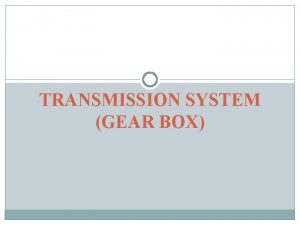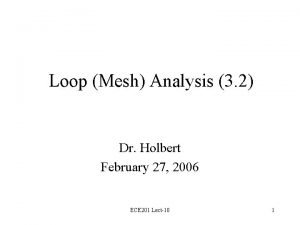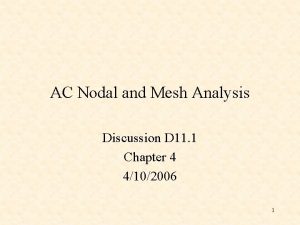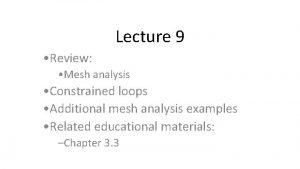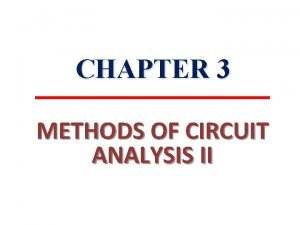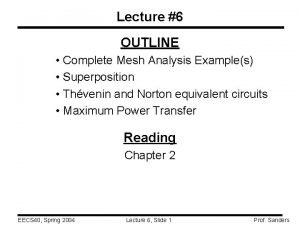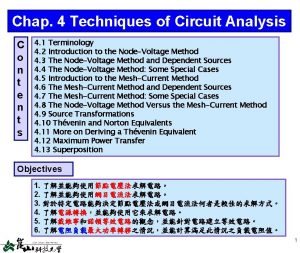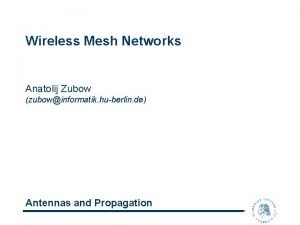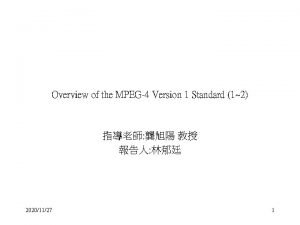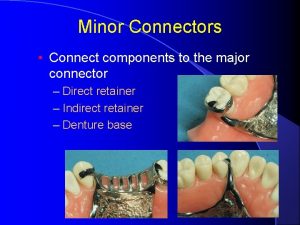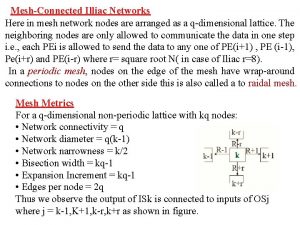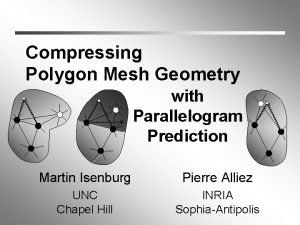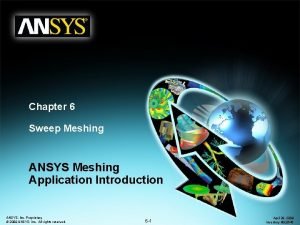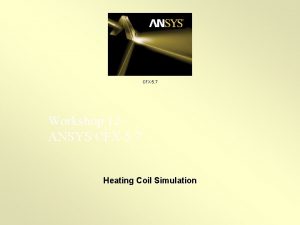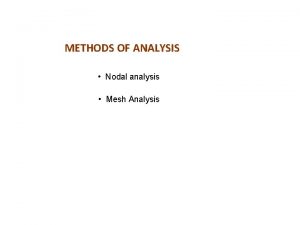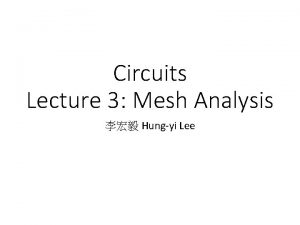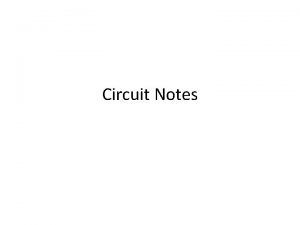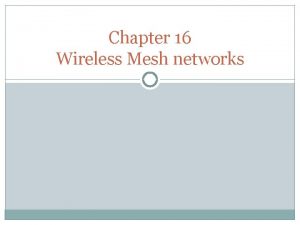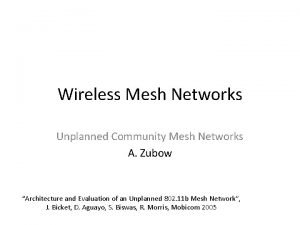CHAPTER 3 METHODS OF CIRCUIT ANALYSIS II MESH









































- Slides: 41

CHAPTER 3 METHODS OF CIRCUIT ANALYSIS II

MESH ANALYSIS

Mesh Analysis An analysis technique to solve electrical circuit where the mesh currents are used as the circuit variables R 1 V 1 R 2 R 3 meshes V 2

Mesh Analysis Mesh A loop which does not contain any other loops within it. • Apply KVL to find unknown currents

Mesh Analysis Mesh analysis only applicable to planar circuit Mesh analysis cannot be applied to nonplanar circuit Note: Nodal analysis is applicable to planar and nonplanar circuit Planar circuit: A circuit that can be drawn on a plane with no branches crossing

Mesh Analysis Planar circuit

Mesh Analysis Non Planar circuit

Steps to Determine Mesh Currents 1. Assign mesh currents i 1, i 2, …. . , into the n meshes. 2. Apply KVL to each of the n mashes. 3. Use Ohm’s law to express the voltages in terms of the mesh currents. 4. Solve the resulting n simultaneous equations to get the mesh currents.

Mesh Analysis R 1 V 1 i 1 R 2 R 3 i 2 i 1 & i 2 are mesh currents V 2

Mesh Analysis R 1 V 1 Mesh 1 i 1 R 2 R 3 i 2 V 2

Mesh Analysis R 1 V 1 Mesh 2 i 1 R 2 R 3 i 2 V 2

Mesh Analysis From the equations, we obtain:

Example 1 Calculate i 1 and i 2. 2 9 12 36 V i 1 4 i 2 3 24 V

Example 2 4 k 6 V + 9 k i 2 6 k i 1 3 k i 3 12 k

Mesh Analysis with Current Sources • Case 1 • A current source exists only in ONE mesh

Mesh Analysis with Current Sources Mesh 1 Mesh 2

Mesh Analysis with Current Sources • Case 2 • A current source exists between two meshes • Called : supermesh

Supermesh 6 10 Solve the mesh currents 2 20 V + i 1 6 A 4 i 2 Step 1 Assign mesh currents to the meshes Step 2 For every mesh, apply KVL – Using Ohm’s law, write down the equations in terms of mesh currents We cannot write equation for the meshes since we cannot write the voltage drop across the 6 A source in terms of mesh currents!

Supermesh 6 10 SUPERMESH 2 20 V + i 1 6 A 4 i 2 We form a supermesh by EXCLUDING the branch containing the current source and elements connected in series with it KVL for the supermesh : -20 + 6 i 1 + 10 i 2 + 4 i 2 = 0

Supermesh Since we have combined meshes 1 and 2, we lost one equation. We need one more equation to solve the mesh current -20 + 6 i 1 + 10 i 2 + 4 i 2 = 0 We obtain the extra equation by using KCL on the branch current that we have removed. i 2 - i 1 = 6 Step 3 Solve mesh currents in equations obtained in step 2, simultaneously -20 + 6 i 1 + 10 i 2 + 4 i 2 = 0 i 2 - i 1 = 6 i 1 = - 3. 2 A, i 2 = 2. 8 A

To summarize …. We form a supermesh when there is a current source in a branch sharing 2 mesh currents Supermesh has no current of its own. To solve the mesh currents, we need extra equation which can be obtained by applying KCL in the branch containing the current source.

Supermesh : Example 3 2 6 V + - 2 i 2 i 1 4 1 3 A i 3 8

Supermesh : Example 3 2 6 V + - i 1 2 i 2 4 1 3 A i 3 8

SUMMARY ON NODAL AND MESH ANALYSIS

SUMMARY • Both techniques provide systematic steps in solving electric circuit • Nodal applicable to all circuits, Mesh only applicable to planar circuit • NOT ALL circuits require nodal or mesh analysis to solve them. • If nodal or mesh analysis is required, choose the one which will give the fastest or simplest steps

Nodal vs Mesh Analysis : : Networks that contain many series connected elements, voltage sources, or supermeshes are more suitable for mesh analysis. : : Networks with parallel-connected elements, current sources, or supernodes are more suitable for nodal analysis. : : If node voltages are required, it may be expedient to apply nodal analysis : : If branch or mesh currents are required, it may be better to use mesh analysis.

NODAL ANALYSIS Step 1 Determine the reference node: typically the one with the most branches Step 2 Assign the rest of the nodes with node voltages (referred to the reference node) Step 3 Write down equations using KCL for every non-reference node in terms of node voltages Step 4 Obtain the node voltages by solving the simultaneous equations in step 3

NODAL ANALYSIS va i 1 vb R 1

NODAL ANALYSIS i 2 va R 1 vb

NODAL ANALYSIS i 1 R 1 Vs va

NODAL ANALYSIS i 1 R 1 Vs R 2 va

NODAL ANALYSIS i 1 R 1 Vs R 2 va

NODAL ANALYSIS va Vs

NODAL ANALYSIS i 1 va R 1 Vs vb

NODAL ANALYSIS i 2 va R 1 Vs vb

NODAL ANALYSIS SUPERNODE va Constraint equation: Vs vb

MESH ANALYSIS Step 1 Assign mesh currents to the meshes Step 2 For every mesh, apply KVL – Using Ohm’s law, write down the equations in terms of mesh currents Step 3 Solve mesh currents in equations obtained in step 2, simultaneously

MESH ANALYSIS i 2 R 1 Vs Mesh 1: R 2 i 1 i 3 -Vs + R 1(i 1 – i 2) + R 2(i 1 – i 3) = 0

MESH ANALYSIS Is i 2 i 3 i 1 Mesh 2: i 2 = Is

MESH ANALYSIS i 2 ii 1 SUPERMESH Is ii 33 Constraint equation : i 1 – i 3 = I s

END OF CHAPTER 3
 Sliding mesh gear system
Sliding mesh gear system Non planar circuit
Non planar circuit Find v
Find v Mesh analysis matrix method
Mesh analysis matrix method Mesh analysis 3 loops
Mesh analysis 3 loops Ac nodal analysis
Ac nodal analysis Mesh analysis
Mesh analysis Mesh analysis
Mesh analysis Diode law
Diode law Mesh analysis examples
Mesh analysis examples 4 v analysis
4 v analysis Fabrication of wax pattern
Fabrication of wax pattern Circuit training methods
Circuit training methods Circuit training disadvantages
Circuit training disadvantages Disadvantages of series circuits
Disadvantages of series circuits Parallel circuit with 3 bulbs
Parallel circuit with 3 bulbs Phet circuit construction kit
Phet circuit construction kit Series vs parallel current
Series vs parallel current Incomplete circuits
Incomplete circuits Parallel circuit short circuit
Parallel circuit short circuit Venn diagram of active and passive voice
Venn diagram of active and passive voice Pulmonary circuit and systemic circuit
Pulmonary circuit and systemic circuit What is a parallel circuit in physics
What is a parallel circuit in physics Sky q mesh network diagram
Sky q mesh network diagram Star mesh topology
Star mesh topology Service mesh
Service mesh Fem mesh
Fem mesh Mpeg-4 mesh animation
Mpeg-4 mesh animation Maesh service mesh
Maesh service mesh Embrasure minor connector
Embrasure minor connector Minor connector in rpd
Minor connector in rpd Iskxxosj
Iskxxosj Arrow mesh wifi
Arrow mesh wifi Meshnet: mesh neural network for 3d shape representation
Meshnet: mesh neural network for 3d shape representation 11s mesh solutions
11s mesh solutions Mesh wifi handoff
Mesh wifi handoff Polygon predictions
Polygon predictions Ansys mesh sweep
Ansys mesh sweep Patch conforming tetrahedral mesh failed
Patch conforming tetrahedral mesh failed How to save mesh file in ansys workbench
How to save mesh file in ansys workbench Air ties
Air ties Planet mesh
Planet mesh
